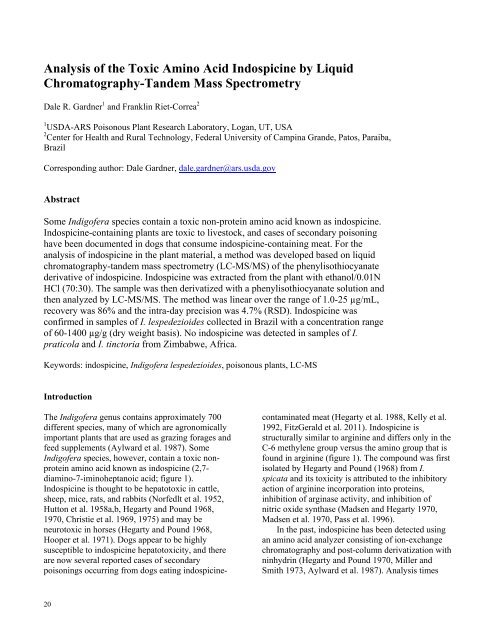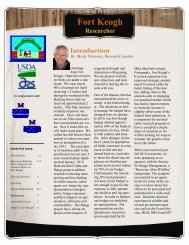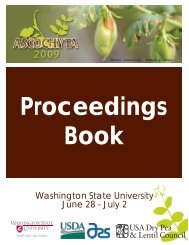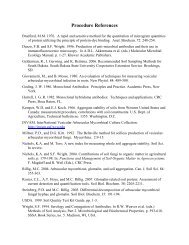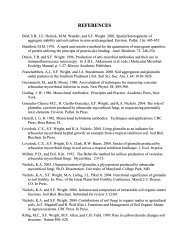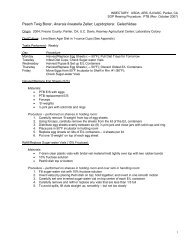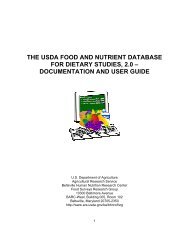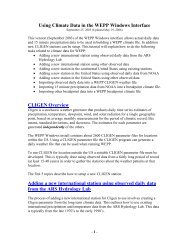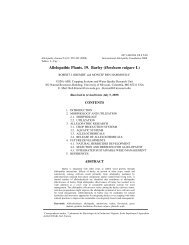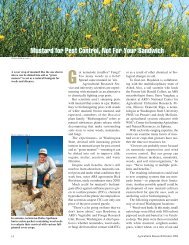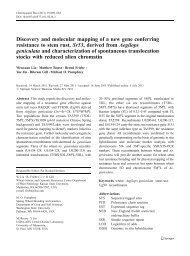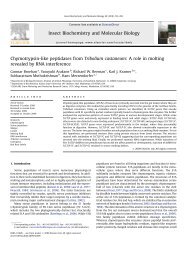International Journal of Poisonous Plant Research - Agricultural ...
International Journal of Poisonous Plant Research - Agricultural ...
International Journal of Poisonous Plant Research - Agricultural ...
You also want an ePaper? Increase the reach of your titles
YUMPU automatically turns print PDFs into web optimized ePapers that Google loves.
Analysis <strong>of</strong> the Toxic Amino Acid Indospicine by Liquid<br />
Chromatography-Tandem Mass Spectrometry<br />
Dale R. Gardner 1 and Franklin Riet-Correa 2<br />
1USDA-ARS<br />
<strong>Poisonous</strong> <strong>Plant</strong> <strong>Research</strong> Laboratory, Logan, UT, USA<br />
2<br />
Center for Health and Rural Technology, Federal University <strong>of</strong> Campina Grande, Patos, Paraiba,<br />
Brazil<br />
Corresponding author: Dale Gardner, dale.gardner@ars.usda.gov<br />
Abstract<br />
Some Indig<strong>of</strong>era species contain a toxic non-protein amino acid known as indospicine.<br />
Indospicine-containing plants are toxic to livestock, and cases <strong>of</strong> secondary poisoning<br />
have been documented in dogs that consume indospicine-containing meat. For the<br />
analysis <strong>of</strong> indospicine in the plant material, a method was developed based on liquid<br />
chromatography-tandem mass spectrometry (LC-MS/MS) <strong>of</strong> the phenylisothiocyanate<br />
derivative <strong>of</strong> indospicine. Indospicine was extracted from the plant with ethanol/0.01N<br />
HCl (70:30). The sample was then derivatized with a phenylisothiocyanate solution and<br />
then analyzed by LC-MS/MS. The method was linear over the range <strong>of</strong> 1.0-25 µg/mL,<br />
recovery was 86% and the intra-day precision was 4.7% (RSD). Indospicine was<br />
confirmed in samples <strong>of</strong> I. lespedezioides collected in Brazil with a concentration range<br />
<strong>of</strong> 60-1400 µg/g (dry weight basis). No indospicine was detected in samples <strong>of</strong> I.<br />
praticola and I. tinctoria from Zimbabwe, Africa.<br />
Keywords: indospicine, Indig<strong>of</strong>era lespedezioides, poisonous plants, LC-MS<br />
Introduction<br />
The Indig<strong>of</strong>era genus contains approximately 700<br />
different species, many <strong>of</strong> which are agronomically<br />
important plants that are used as grazing forages and<br />
feed supplements (Aylward et al. 1987). Some<br />
Indig<strong>of</strong>era species, however, contain a toxic nonprotein<br />
amino acid known as indospicine (2,7diamino-7-iminoheptanoic<br />
acid; figure 1).<br />
Indospicine is thought to be hepatotoxic in cattle,<br />
sheep, mice, rats, and rabbits (Norfedlt et al. 1952,<br />
Hutton et al. 1958a,b, Hegarty and Pound 1968,<br />
1970, Christie et al. 1969, 1975) and may be<br />
neurotoxic in horses (Hegarty and Pound 1968,<br />
Hooper et al. 1971). Dogs appear to be highly<br />
susceptible to indospicine hepatotoxicity, and there<br />
are now several reported cases <strong>of</strong> secondary<br />
poisonings occurring from dogs eating indospicine-<br />
20<br />
contaminated meat (Hegarty et al. 1988, Kelly et al.<br />
1992, FitzGerald et al. 2011). Indospicine is<br />
structurally similar to arginine and differs only in the<br />
C-6 methylene group versus the amino group that is<br />
found in arginine (figure 1). The compound was first<br />
isolated by Hegarty and Pound (1968) from I.<br />
spicata and its toxicity is attributed to the inhibitory<br />
action <strong>of</strong> arginine incorporation into proteins,<br />
inhibition <strong>of</strong> arginase activity, and inhibition <strong>of</strong><br />
nitric oxide synthase (Madsen and Hegarty 1970,<br />
Madsen et al. 1970, Pass et al. 1996).<br />
In the past, indospicine has been detected using<br />
an amino acid analyzer consisting <strong>of</strong> ion-exchange<br />
chromatography and post-column derivatization with<br />
ninhydrin (Hegarty and Pound 1970, Miller and<br />
Smith 1973, Aylward et al. 1987). Analysis times


